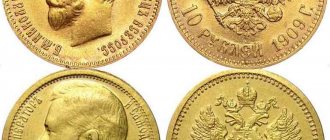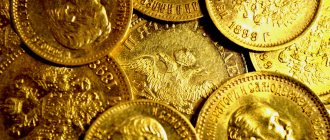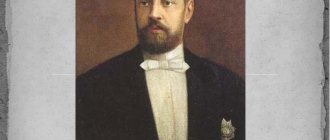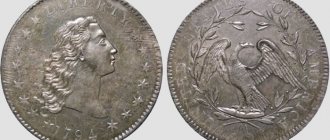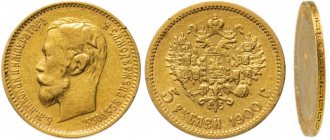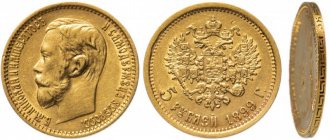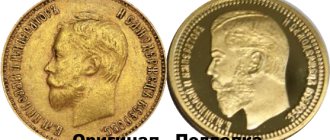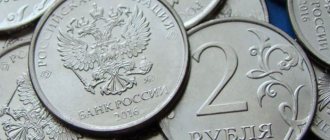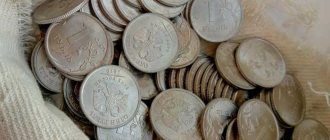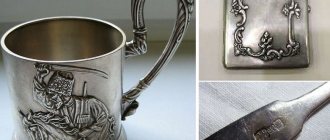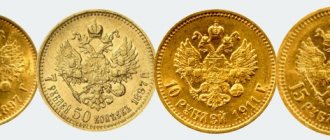Hello! Let's talk about history. At the very beginning of the 18th century, Peter I reformed the state system. The reason was an urgent need for money: the army, navy, the Northern War (it would last another 20 years) - all this required funds.
The reform took place in many stages and included various measures to influence the economy. We are interested in the fact that during the reform in 1701, the first royal gold coins, chervonets, were minted at the Kadashevsky Mint. The prototype of the royal chervonets was the European ducat, and this meant that the first circulating (circulation, settlement) coin appeared in the Russian Empire.
Before the chervonets, in Tsarist Russia, gold coins were donative - gift coins, intended for rewarding and expressing gratitude. They were presented to their subjects by the emperor and grand dukes as gratitude for their loyalty and on important occasions. Such money was not intended for everyday circulation and differed in mintage.
Now everything has become different - gold was included in the calculation, which was purchased in large quantities from China for this occasion. Since then, every Russian leader until the 20th century considered it necessary to imprint his profile on at least a small batch of money.
Types of gold coins from royal times
Royal coins began to be issued at the Kadashevsky Mint, and a little later the Red Mint joined in. This building in Moscow, not far from the Resurrection Gate, has survived to this day and has the status of an architectural monument of tsarist times. Under Anna Ioannovna, the Kadashevsky yard was closed, and the St. Petersburg Mint, founded in 1724, joined the Krasny one.
Peter I
In Peter's times, three types of gold coins were issued for regular minting and one for foreign payments.
Here are the three main coins of Peter I:
- chervonets;
- double chervonets;
- two rubles.
The gold chervonets of that time did not have a denomination. But there was a hint of the power of the Russian Empire over the seas: the Baltic, White, Azov and Caspian in the form of four cards minted on the reverse. On the royal chervonets, intended for internal payments, the inscriptions were in Cyrillic, on foreign ones - in Latin.
Two-ruble coins began to be minted in 1718 - they replaced the golden chervonets. This was probably done for the sake of economy: Chinese gold has risen in price significantly. For mutual settlements with Europe, ducats or their analogues were required, but gold royal coins with a face value of 2 rubles took root in the domestic market and were minted for two more generations of emperors.
Catherine I
Catherine I also carried out a monetary reform, but it affected only silver and copper. Catherine's gold coin was similar to Peter's - St. Andrew the First-Called was also minted on its reverse (as under Peter), but the portrait of Peter on the obverse was replaced by the profile of Catherine herself.
Peter II
Peter II continued the tradition and issued the same St. Andrew's 2 rubles (of course, with his portrait) in several versions. The production of the royal two-ruble coins was stopped only in 1729 - it became difficult to ignore their unsuitability for foreign economic calculations, because ducats were still needed in Europe.
Also in 1729, a new gold chervonets was issued, which had no face value, like the first ones, with a double-headed eagle and the coat of arms of Moscow on the reverse. The choice of coat of arms is strange at first glance - by that time, St. Petersburg had been the capital of the Russian Empire for 17 years. However, in 1728, Peter II planned to return Moscow to capital status and moved there himself - apparently, this intention is reflected in the gold coinage. It did not justify itself: in 1730 Peter died, and St. Petersburg remained the main city of the country for almost 200 years.
Anna Ioannovna
Empress Anna again reformed the royal financial policy. Peter's gold money was taken out of circulation, and new ones were minted in its place - of course, with the profile of Anna herself in an ermine robe. The chervonets did not have a denomination, but the standard increased sharply: 781 metric turned into 968. Coins became more expensive to produce, softer and required careful handling.
Under Anna Ioannovna, the Red Mint also minted a coin that has not survived to this day - the “Dutch chervonets”, the stamps for which have also not survived.
Elizabeth
Elizaveta Petrovna ruled for 20 years and during this time she managed to mint a lot of money. Of course, she herself was depicted on the obverse of all coins of her era. The reverses were different: there were a chervonets and a double chervonets with the image of St. Andrew the First-Called and the same coins with a double-headed eagle. The denomination on the royal money was again missing.
Brand new gold coins were also issued:
- Trial denominations of 5 and 10 rubles (imperial and semi-imperial), called “Elisavetin Gold”.
- Trial denominations of 1 and 2 rubles.
- Coins for palace use in denominations of 1, 2 rubles and 50 kopecks are the so-called “dvortsovki”. There is evidence that they were used more widely and were used for payments by ordinary citizens, although they were issued mainly for card games.
“Palace” coins continued to be produced after the death of Elizabeth - Russian emperors were not inclined to asceticism and royally enjoyed the luxury available to them.
Peter III
Peter III continued the minting of gold imperials and semi-imperials with a composition of coats of arms on the reverse (the royal coat of arms was located in the center) - and the same chervonets, an analogue of European ducats. The mass of a chervonets without a denomination was equal to the mass of a ducat - 3.47 g, diameter - 20 mm. The previous royal chervonets had approximately the same parameters.
During the reign of Peter III, chervonets began to be produced for the first time at the St. Petersburg Mint; before that, only Krasny was involved in them.
Catherine II
Catherine the Great began secretly issuing “Dutch ducats” - an imitation of European money. Evidence of him, modest at that time, dates back to the reign of Anna Ioannovna. Europeans treated such money more loyally than the royal gold chervonets. In addition, under Catherine, the proportional relative value of gold and silver was officially established (in 1764) - before this, exchange rate fluctuations interfered with calculations.
The production of tsarist imperials, half-imperials (10 and 5 rubles), two-ruble coins, rubles and half-rules - coins with a face value of 50 kopecks - continued.
There is information about a ruble coin allegedly for participants in the palace coup, minted in 1762 in the amount of 10 pieces. It is present in many catalogues, but we have no reliable information about it. If such a royal ruble were now found in a private collection, it would be worth a colossal amount of money.
Paul I
Under Paul I, there were only two regularly minted coins. This:
- A golden chervonets with a double-headed eagle (or Paul’s monogram) and the inscription “Not for us, not for us, but for Your name.”
- Royal semi-imperial made of almost pure 986 gold.
You probably noticed that Paul I - alone of all - suddenly changed the narcissistic tradition and minted coins without his own portrait. Why - one can only guess. It’s not a matter of appearance: portraits of Paul have been preserved, which he did not refuse, and there was nothing repulsive in his face.
There is a version that, unlike his predecessors, who were busy with palace intrigues and costly wars, Paul I considered getting out of the crisis and paying off debts as his priorities (Catherine left him millions in loans as an inheritance). The new emperor wanted to rely on internal resources and ordered the minting of coins that were the simplest, cheapest to design and produce.
According to some information, initially the gold chervonets with the profile of Paul I was in the project, but it had to be abandoned due to the need to urgently revise the denominations and technology for issuing coins.
Alexander I
In addition to the usual imperials and semi-imperials, under Alexander I, mints minted gold coins in denominations of 25 and 50 zlotys for introduction into use on the territory of the Kingdom of Poland, which was accepted into the Russian Empire by the decision of the Congress of Vienna in 1815. Zlotys were made from 917 standard metal.
The issue of “Dutch chervonets” continued. Some test royal coins were also produced, about which it is now difficult to say anything.
Nicholas I
Nikolai, nicknamed Palkin, added Russian-Polish money with double denominations to the Polish zlotys: 3 rubles - 20 zlotys. They were minted in St. Petersburg and Warsaw after military operations in Poland (Polish Uprising, 1830–1831).
Another new Nikolaev coin is a commemorative one, issued in honor of the beginning of minting gold from the Kolyvano-Voskresensky mines (with a face value of 5 rubles). Unnominal royal “ducats”, gold semi-imperials and imperials also remained in circulation.
Alexander II
Under Alexander, semi-imperials continued to be produced and a new regular gold coin appeared - 3 rubles. It was ordered to be issued instead of “Dutch ducats”, which was done, but the remains of them were still circulated among the people for 2 rubles 85 kopecks. They released a limited edition of commemorative royal 25 rubles of 1876, commissioned by Grand Duke Vladimir Alexandrovich in honor of his thirtieth birthday.
Zlotys were not minted under Alexander, but the production of Finnish stamps was established for the Principality of Finland, which became part of the Russian Empire as a result of the Russian-Swedish war (1808–1809). The Helsingfors Mint, established in 1861, was used to issue gold stamps.
Alexander III
The Tsar the Peacemaker continued the production established by his father, and until 1885 he issued the same gold coins.
In 1885, he published the “Rules on the Coin System” and stopped issuing three-ruble notes, but he resumed two traditions at once:
- minting of royal imperials;
- image on gold coins of one’s own portrait.
Nicholas II
Nicholas, who is now often called the Saint, and was called the Bloody by his contemporaries, from 1897 to 1899 minted a new gold denomination - 15 and 7.5 rubles. By this time, monetary circulation in Russia was already relatively orderly; S.Yu. was appointed Minister of Finance. Witte, and the ruble actually devalued by ⅓ - now the same amount of gold has become one and a half times more expensive.
Nicholas issued gold donation coins in honor of his coronation and fortieth anniversary and tried to establish the production of “Russ” - a monetary unit planned for the introduction, which was never destined to enter into circulation.
Gold money of English-speaking countries
In the United States of America, the history of minting its own gold coins started at the very end of the 18th century. Their first graduation took place there in 1795. First of all, the local mint began producing gold coins with unusual denominations of 10.5 and 2.5 dollars.
Subsequent US coin issues are associated with important events and names
| Denominations | Traces in history |
| In the States, they began minting gold money in one dollar and 20 dollar units. | This happened after the discovery of rich gold deposits in California and the subsequent “gold rush” (mid-19th century). |
| In 1853, another unusual gold coin came into circulation: a denomination of three dollars. | This non-standard amount was issued specifically for those who sent a lot of mail. The fact is that at that time one postage stamp cost 3 cents. For the convenience of purchasing it, a silver three-cent coin was specially created. But 3 gold dollars were intended to purchase a whole sheet of postage stamps, consisting of hundreds of stamps. |
| In 1907, the United States began minting twenty-dollar gold coins, nicknamed “Saint-Gaudens double eagles” for their appearance. | Saint-Gaudens is the architect who had a hand in the design of these gold coins. |
Such coins were made from gold of 900 standard, and each copy weighed 33.43 grams.
The cost of one such gold coin exceeded the monthly income of quite a few US residents at the beginning of the twentieth century. Therefore, “double eagles” immediately gained fame as a symbol of wealth and prosperity, because only a few lucky ones had such gold money in their wallets. Mass production of gold coins ceased in the States during the Great Depression (1929−1939) due to the difficult economic situation in the country.
In Great Britain, the first gold sovereigns - the most famous English money - were issued at the end of the 15th century, during the reign of King Henry VII. In 1489, a coin was produced, decorated with the image of a king sitting on a throne. Because of this design, this ancient coin was nicknamed the sovereign: from the word “sovereign,” which means “monarch, supreme ruler.” It weighed 15.5 grams, and its diameter reached 39.5 centimeters.
Its release was periodically stopped and then resumed again. In 1817, they began to produce it again, but in a smaller weight - about eight grams. The new design always features the profile of the current monarch on one side of the coin, and St. George spearing a serpent on the other.
During the First World War, due to the general difficult financial situation in the state, the issue of gold English sovereigns was stopped. It was subsequently resumed in 1957, but for collection purposes. Queen Elizabeth II is a crowned centenarian, and therefore today there are four types of sovereigns with her profile. They differ in their portraits of Elizabeth, reflecting the different ages of the queen.
Despite the fact that gold sovereigns are considered collectible coins, you can pay with them if you wish, since by law they are accepted as a full-fledged currency.
The rarest and most expensive coins of the period of Tsarist Russia
You can buy a coin at auction for $400 and sell it for £1.5 million. This happened in 2008 to a man (his name is unknown) who accidentally acquired an Elizabethan gold coin of 20 rubles (double imperial) in 1950. It was released as a test batch and never appeared in circulation. Besides the copy sold in 2008, only one is now known - it is kept in the State Hermitage (St. Petersburg).
Proof and non-circulation coins are expensive due to their rarity. But regular royal coinage is also valued, especially:
- Royal coins with manufacturing defects or those that were minted after the first issue using new stamps. This made the first printing rare.
- Money, most of which was melted down, like “Dutch ducats,” which were hastily replaced with gold royal three-ruble notes.
Not all collectible coins are made of precious metals. History is valued more than gold, and the cost of a copper penny can be fabulous, if this penny is from tsarist times, and even more so rare.
What investment coins can you buy today?
The most famous of the modern investment coins is St. George the Victorious.
You can also purchase:
- Sower.
- Russian ballet.
- Zodiac signs.
- River beaver.
- Winter Olympic Games.
- History of monetary circulation in Russia.
- FIFA World Cup 2021.
Why are chervonets and 15 rubles with Nicholas III a priority in Russia?
Coins of 5 and 10 rubles, which became 7.5 and 15 rubles respectively as a result of Witte’s monetary reform, formed the basis of the monetary circulation of the Russian Empire. They were produced in millions of copies and were widely distributed.
Interesting fact: the 10-ruble imperials, which were minted in 95-97 of the 19th century, represent a statistical anomaly. Although this example is not very rare (its circulation was 125 pieces annually, about 375 in total), collectors are willing to shell out up to a quarter of a million dollars for it.
How much do investment gold coins cost in Sberbank of Russia today?
Expert opinion
Lyudmila Pestereva
Our most experienced gold investor
Ask a Question
The cost of investment coins in Sberbank ranges from 25 to 40 thousand per copy, made of gold, worth 50 rubles and weighing 7.78 grams of pure gold. Why there is such a difference in price is difficult to answer. Sberbank of Russia does not comment on pricing on its website: it probably depends on the expected demand for individual copies.
The bank also offers wholesale pricing options for batches of 10 items and above. The price is reduced by 1-2 thousand per unit.
The most expensive copy - Suvorov 2000, which, however, does not belong to investment coins, but to commemorative signs, with a similar weight and denomination - is offered to be purchased for 400 thousand.
Is it worth investing in gold coins?
It is possible to invest profitably in royal gold, but it is worth studying in advance the pros and cons of such an investment.
Expert opinion
Alexander Ivanovich
Private collector with 4500+ coins and bonds in his personal collection. Knows the value of each of them today.
The value of royal coins varies from several hundred or thousand rubles (the least rare small money) to millions. The semi-imperial of 1869 (the reign of Alexander II) will cost 30-35 thousand rubles, but the gold Nicholas imperial of 1896 (the last circulation before devaluation) will cost 8,000,000.
The era of Elizabeth Petrovna
But in the era of Elizabeth Petrovna, money reform began again. The production of gold coins resumed. Along with the previous denominations, new copies appeared. For internal circulation, in addition to chervonets with the image of the empress printed on them, the following were made: double chervonets, half treasury, 1 ruble, 2 rubles.
And already in November 1755, the assortment was replenished with ten-ruble (imperial) and five-ruble (half-imperial) copies, which were used to accompany foreign trade transactions. And if the obverse of these coins, according to established tradition, was decorated with a portrait of the empress, then on their reverse there was a cross-shaped figure, on the edges of which there were 4 shields of cities of the Russian Empire with coats of arms and other symbols applied to them, and in the center there was a fifth, where the two-headed an eagle holding the royal regalia - a scepter and an orb.
By the way, the most expensive coins appeared at the time when the country was ruled by Catherine II. These are gold items with a face value of 20 rubles. There were very few of them. They were test pieces that arose during the transition to another minting technology. That's why the auction offered such a fabulous price of several million dollars.
Advantages and disadvantages
Here are the positive qualities of investing in antique coins:
- Potentially High Returns – Antiques appreciate in value over time, and your coin could skyrocket in value if it is rare and well-preserved.
- The opportunity to find an expensive rarity for next to nothing (the probability is small, but it exists).
- An opportunity to collect a collection - a number of gold coins from the same era. It will cost more than if sold separately.
- The absence of a certificate does not devalue the gold (as is the case with a bullion).
Those who decide to invest in antiquities should also be aware of the negative aspects. I will include among them:
- The need for deep immersion in the topic. If you are not ready to get carried away with numismatics, but want to have “real” gold in your assets, it is better to focus on investment coins.
- VAT, which is levied on money out of circulation. This is where bullion coins also win.
- Problems associated with restrictions on the export of antiques abroad.
- Expenses for conducting an examination (from 500 rubles to several thousand per coin).
- The need to handle the collection with extreme care. This is not just gold, but also a unique stamp, already damaged by time, which cannot be restored.
To summarize: numismatics is a specific area that you need to understand if you want collecting to generate income. Investing in Tsarist gold will pay off if you are interested in history and involved in the collecting community.
Reign of Nicholas II
The next stage in the development of gold coins in Tsarist Russia dates back to the reign of Nicholas II. That's who pleased numismatists. He tried to replace rubles by offering unusual gold money, the so-called “Rus”. The 3 trial coins in denominations of 5, 10 and 15 russ did not pass the tests, the tsar simply did not like them. But modern collectors are ready to pay any price for the set, and the auction determined it - about 500 thousand dollars.
But here’s a paradox: there is a directory with a certain price, but the product itself is missing. Of course, it exists, and not even in one copy (5 sets have survived). But clearly no one is going to put them up for sale.
Another valuable and rare coin is 10 rubles issued in 1906. The main reason is the very limited edition of 10 pieces. In this regard, the auction offered 500 thousand rubles for it.
Of no less interest is a coin with a very original denomination - 37.5 rubles. Where did this denomination come from? There are several versions. According to one of them, it served as a convenient means for casino players, according to another, it personified the alliance and friendship between Russia and France. The auction set a price for it - from 40 to 150 thousand dollars.
During the entire existence of Tsarist Russia, many different and interesting specimens were produced. Of course, all gold coins of the Russian Empire arouse genuine interest among collectors around the world. Each of them is beautiful, original, and has its own price. But in order to find out it for the purpose of subsequent ransom, you need to have information. And here such “helpers” as an auction, a directory, and a catalog come to the fore.
Where can you buy or sell
A rare gold coin is not a product that can be sold in one day. First of all, such gold is sold in antique stores and at numismatic auctions. Trading platforms are based on the Internet, for example:
- Anumis;
- Volmar;
- Raritetus;
- Monetshop;
- Imperial;
- Conros;
- Numismatist and others.
You should not look for buyers of ancient coins on bulletin boards: even if someone covets your product, most likely it will be a scammer who buys expensive things for next to nothing from people who do not know their real value.
If you are a novice collector, pay attention to thrift stores and flea markets (for example, Udelny in St. Petersburg). Sometimes you can find unique antiques on them, including royal coins.
Prices for royal gold coins today
The table shows how much gold royal coins are worth now (depending on the type, according to the portal monetnik.ru).
What about today?
The value of the gold coin today cannot be overestimated. Storing savings in this format ensures stability and security of investments. The advantages that contribute to the choice of gold for investment are:
- reliability of purchase and sale transactions;
- purchasing coins in any region of the country;
- correspondence of the cost of products to prices on the world market of precious metals;
- selection of denominations of various denominations.
Citizens of Russia can buy products whose weight ranges from hundredths of a gram to 5 kilograms (anniversary limited edition).
Regardless of the state of the economy and political situation in the country, gold is still the best way to store and increase funds. If you have already decided to invest in gold coins, then this is the place for you.
